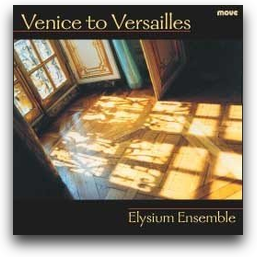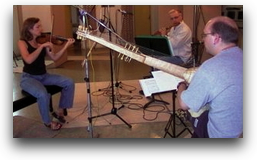Venice to Versailles

Move Records MD 3260
The title ‘Venice to Versailles’ evokes the idea of a journey or the movement from one place (or state) to another. The works recorded here certainly present an intriguing musical journey through the diversity of instrumental chamber music of the sixteenth, seventeenth and eighteenth centuries: sets of variations on vocal works and ground basses, dances, sonatas and suites from Italy and France.
On another level, the affections or passions—universal states of the soul, such as rage, melancholy, joy or mystic exaltation—of the attentive listener will be moved.
Venice (late sixteenth to early seventeenth century) and Versailles (late seventeenth to early eighteenth century) were two of the most important centres for the arts in Europe. They represent the two dominant and contrasting styles of music during the Baroque period: Venice, the robust, joyous exuberance and barocco (‘wild’ or ‘grotesque’) character of the Italian style, and Versailles, the refinement, delicacy, elegance and douceur (‘sweetness’) of the French.
The cover photograph depicts these ideas wonderfully. In it we see the parquet floor of Louis XIV’s sitting room at Versailles, with its precise yet classically cool and well proportioned design, bathed in the warm glow of autumn sunlight (I like to think of it as a Mediterranean sun). The photograph is also a beautiful study of darkness and light. The dramatic contrast of light and shade (chiaroscuro) was a technique used by Baroque painters to express emotion. Baroque composers also sought to express, or rather, represent, a wide range of ideas and feelings with the utmost vividness. From Monteverdi to Bach, they sought new musical means for the expression of the affections or passions, and to intensify these musical effects by means of (sometimes violent) contrasts.
Read more about the music and composers in the Program Notes.
Performers

Elysium Ensemble in the Move recording studio
recording Venice to Versailles (2002)
- Greg Dikmans
- baroque flute and recorders
- Lucinda Moon
- baroque violin
- Simon Martyn-Ellis
- lute, theorbo and baroque guitar
Program
Giovanni Bassano (c. 1558-1617)
- Ricercata Quarta
-
Ricercate, passaggi et cadentie… (Venice, 1585)
recorder solo - Susanne ung jour (after Roland de Lassus)
-
Motteti, madrigali et canzoni francese…diminuti (Venice, 1591)
violin and lute - Frais et gaillard (after Clemens non Papa)
-
Motteti, madrigali et canzoni francese…diminuti (Venice, 1591)
recorder and lute
Giovanni Girolamo Kapsberger (?-1651)
- Toccata No. 3
-
Libro primo d’intavolatura di chitarone (Venice, 1604)
theorbo solo
Dario Castello (?-1658)
- Sonata Prima à sopran solo
-
Sonate Concertate… (Venice, 1629)
violin and theorbo
Giovanni Paolo Cima (c. 1570-?)
- Sonata à 3
-
Concerti ecclesiastici… (Milan, 1610)
recorder, violin and theorbo
Diego Ortiz (c. 1510-c. 1570)
- Recercada Ottava — Recercada Segunda
-
Trattado de glosas… (Rome, 1553)
recorders, violin and baroque guitar
Marco Uccellini (c. 1603-1680)
- Aria sopra la Bergamasca
-
Sonate, arie et correntia… (Venice, 1642)
recorder, violin and baroque guitar
Jacques Hotteterre (1674-1763)
- Première Suite de pièces a deux dessus… (Paris, 1712)
- flute and violin
-
- [Ouverture] (gravement—gay)
- Allemande (gay)
- Rondeau—Les Tourterelles (gracieusement, et un peu lent)
- Gigue
Robert de Visée (mid 17th century-early 18th century)
- Suite in A minor
- theorbo solo
-
- Prelude
- Allemande—La Royalle
- Courante du même
- Chaconne
Jacques Hotteterre (1674-1763)
- Troisième Suite — Pièces pour la flûte-traversière… (Paris, 1708)
- flute and theorbo
-
- Allemande—La cascade de St. Cloud (piqué)
- Sarabande—La Guimon
- Courante—L’indiferente (légèrement)
- Rondeau—Le plaintif (tendrement)
- Menuet—Le mignon (un peu doucement)
- Gigue—L’Italienne
François Couperin (1668-1733)
- Troisième livre de pièces de clavecin (Paris, 1722)
- flute, violin and theorbo
-
- Muséte de Choisi: Première partie (tendrement)—Seconde partie (mineur)
- Muséte de Taverni: Première partie (légèrement)—Seconde partie (mineur)
Reviews
‘A pleasant, easy-listening, well recorded and recommended CD’
Venice to Versailles
The Elysium Ensemble—Greg Dikmans, baraoque flute & recorders; Lucinda Moon, baroque violin; & Simon Martyn-Ellis, baroque guitar, lute & theorbo—perform nicely on this disk of short Italian and French chamber pieces of the 16th to 18th centuries.
Sweet and flowing recorder, gently punctuated, make for a delightful opening track—Ricercata Quarta by Giovanni Bassano.
Soothing, expressive violin with simple lute accompaniment, follow in an instrumental rendition of a song by the same composer.
Close behind is a theorbo solo by Kapsberger, and Sonata Prima a sopran solo (violin & theorbo) by Dario Castello.
An exceptionally appealing work is the Spanish flavoured Ortiz, Recercada Ottava-Recercada Segunda, with recorder, unobtrusive violin & guitar. This instrumentation then produces a delightful Bergamasca by Uccellini.
And, at this stage the disc isn’t half-way through.
Add flute pieces by Hotteterre and Musettes de Choisi and de Taverni by François Couperin, and you have a pleasant, easy-listening, well recorded and recommended CD.
Neville Olliffe–Early Music News
Journal of the Early Music Association of NSW Inc (Vol. 3 No. 1 Feb/March 2003)
‘A testament to the sophistication of Australia’s knowledge of early music’
Venice to Versailles
This is worthy in conception, style and learning. It brings together three Australian early music specialists playing original instruments and also some fine copies by outstanding Australian instrument-makers in music centred around the court of Louis XIV in France, and Venice of a slightly earlier period.
Baroque violinist Lucinda Moon is best know in Sydney as leader of the Australian Brandenberg Orchestra. Her partners in Elysium are Melbourne flute and recorder player Greg Dikmans and lutenist Simon Martyn-Ellis.
The playing is stylish, sensitive and intelligently informed by baroque aesthetics and playing practice.
There are also subtle pleasures: a radiant sonata from Concerti Ecclesiastici by Milanese composer Giovanni Paolo Cima, some lively semi-improvised music over repeated bass patterns by the 16th-century composer Diego Ortiz, some dance-like variations by Marco Uccellini and the deep plodding bass notes of the otherwise brightly voiced theorbo, made by Tim Guster of Adelaide, in a suite by Louis XIV’s lutenist and guitar teacher, Robert de Visée. There are also two suites by the King’s flautist and bassoonist, Jacques Hotteterre.
The first suite from a 1712 collection adopts the austere intimate sound of solo flute and violin without bass, locked throughout in an intimate embrace of intertwining ornamentation. In the third suite from a 1718 collection, Dikmans is joined by Martyn-Ellis…two movements of this are also captured on an MPEG video (visually this worked well on my computer).
Much of this is a testament to the sophistication of Australia’s knowledge of early music.
Peter McCallum–Sydney Morning Herald (8-9 March 2003)
Instruments
- ‘Ganassi’ soprano recorder in C
- Frederick Morgan, Daylesford.
- ‘Ganassi’ alto recorder in G
- Frederick Morgan, Daylesford, after late 16th-century model.
- Baroque flute
- Rudolf Tutz, Innsbruck, after G. A. Rottenburgh (mid 18th-century).
- Baroque violin
- presumed Italian (c.1700)—set to period specifications.
- Theorbo
- Tim Guster, Adelaide, 2001.
- Baroque Guitar
- Tim Guster, Adelaide, 2000.
- Renaissance Lute
- Peter Biffin, Armidale, 1994.
Credits
- Cover photo:
- The floor of Louis XIV’s sitting room in the palace of Versailles (October, 1997), taken by Felicity Spear.
- Digital photography:
- Greg Dikmans and Judith Caughie.
- Studio:
- Move Records, Melbourne.
- Digital recording and editing:
- Vaughan McAlley.
- Produced by:
- Elysium Ensemble and Martin Wright.
- Booklet design:
- Alessandro Servadei.
- Program notes:
- Greg Dikmans.
- MPEG video production:
- Martin Wright.
The Elysium Ensemble gratefully acknowledges the support of Simone Pérèle.